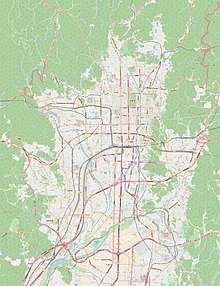Kyoto National Museum
| 京都国立博物館 | |

Façade of museum
|
|
| Established | May 1897 |
|---|---|
| Location | Higashiyama-ku, Kyoto, Japan |
| Coordinates | 34°59′24″N 135°46′23″E / 34.99°N 135.773°E |
| Type | Art museum |
| Public transit access | Shichijō Station, Keihan Main Line |
| Website | http://www.kyohaku.go.jp/ |
The Kyoto National Museum (京都国立博物館 Kyōto Kokuritsu Hakubutsukan?) is one of the major art museums in Japan. Located in Kyoto's Higashiyama ward, the museum focuses on pre-modern Japanese and Asian art.
The Kyoto National Museum, then the Imperial Museum of Kyoto, was proposed, along with the Imperial Museum of Tokyo (Tokyo National Museum) and the Imperial Museum of Nara (Nara National Museum), in 1889, and construction on the museum finished in October, 1895. The museum was opened in 1897. The museum went through a series of name changes, in 1900 changing its name to the Imperial Household Museum of Kyoto, and once more in 1924 to the Imperial Gift Museum of Kyoto. The current name, the Kyoto National Museum, was decided upon in 1952.
The growth and development of today's museum has been an evolving process: history
The museum consists of several buildings, the most prominent being the Special Exhibition Hall (Main Exhibition Hall), designed by Katayama Tōkuma in 1895, and The Collections Hall (New Exhibition Hall), designed in 1966 by Morita Keiichi. In September 2014, the museum completed renovations on a new permanent collections hall, the Heisei Chishinkan Wing (The Collections Galleries), designed by Yoshio Taniguchi, known for his redesign of the Museum of Modern Art in New York and his design of the Gallery of Hōryū-ji Treasures at the Tokyo National Museum.
The regular exhibitions are shown in The Collections Galleries, while the Special Exhibition Hall is used for special exhibits. The Main Exhibition Hall, the Main Gate, and the Ticket Area have all been designated as Important Cultural Properties in Japan.
...
Wikipedia

